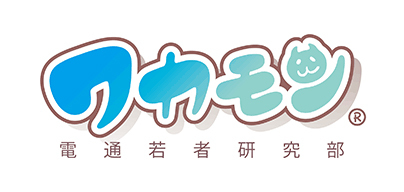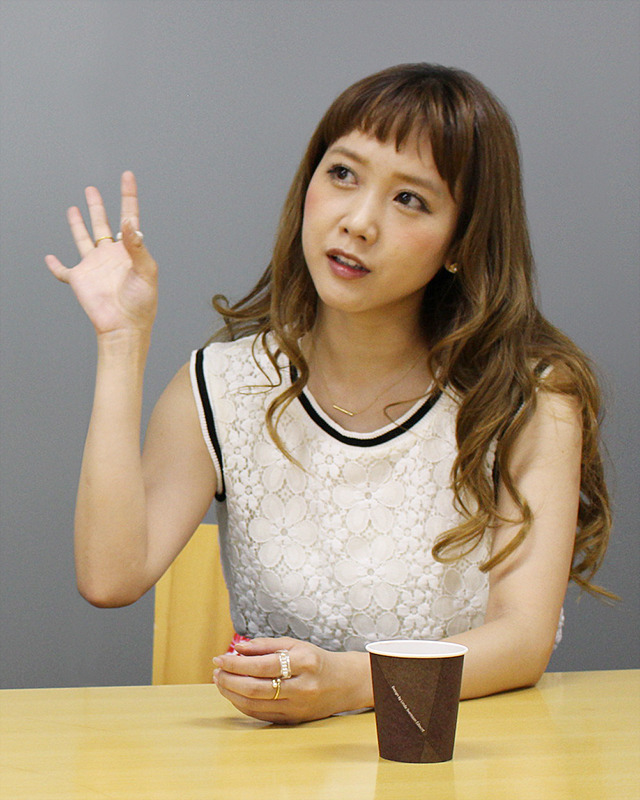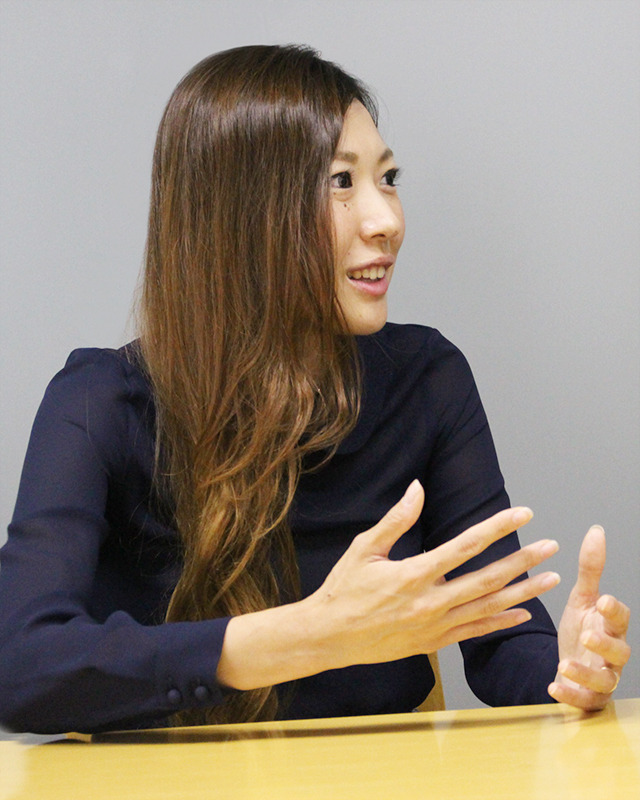
Members of Wakamon, Dentsu's cross-departmental planning team researching the "present and future" of teens and young adults, engage in dialogues with prominent figures exploring new ways of living. This time's guest is Rina Tanaka, a representative model of the "Aomojikei" style (referring to the girly, casual fashion popular among young women in areas like Harajuku, Tokyo, and the magazines that feature it). Wakamon member Mihoko Nishii delves into Tanaka's "self-production skills," which have taken her beyond the typical reader model role to include planning collaborative products with companies across various industries.
Stories born from "what I want" are important
Nishii: Rina, you're involved in such a wide range of activities—planning new products through collaborations with companies, publishing books, and more. What's more, your collaborations aren't limited to apparel makers; they include companies like Yahoo and FamilyMart. It's rare to see a reader model with such a broad scope of activities. When did you start pursuing these kinds of projects?
Tanaka: I've been a reader model for fashion magazines since college. But while living my normal life as a young woman, I often thought, "Wouldn't it be great if there was a product like this?" or "I really want something like that." At first, these ideas would just pop into my head and fade away. But gradually, a sense of obligation started to grow...
Nishii: A sense of obligation?
Tanaka: Everyone thinks "it would be great if there were a product like this," but actually making it happen is pretty tough, right? But I happened to be in a position where, as a reader model, I had media like my blog and Twitter to share information, making it a little easier to make things happen. So, I started thinking that people with a way to share their voice should speak up for other girls' feelings. Back then, I believed everyone has a unique life and there's always one thing only they can do. That's when I felt certain, "This is it for me!" (laughs).
Nishii: So that conviction turned out to be right. You've successfully collaborated with various companies now, but was it smooth sailing from the start?
Tanaka: At first, I thought I had to master expertise in everything I did, so I scoured for knowledge about the products I was collaborating on. But with that superficial knowledge, I could never compete with professionals, nor could I express my true self. So I asked myself, "What can only I do?" This is something I learned the hard way as a reader model: the more specialized knowledge creators gain, the more they tend to lose sight of the consumer's perspective. They prioritize feasibility over what users or readers truly want. That's why I decided to approach products from the viewpoint of a consumer, a girl. Once I started voicing ideas from that position, I could finally create products I was satisfied with.
Nishii: That perspective is crucial when involved in product creation. When trying to understand consumers or girls' feelings, is there anything you're particularly mindful of?
Tanaka: My baseline is my own standards. I ask myself if I would genuinely love wearing or using it. After pursuing that ideal, I observe everyone's reactions and what they're wearing on Twitter or at events to expand my ideas. When I'm really stuck, I'll even ask directly on Twitter, "Which one do you like better, this or this?" (laughs). Beyond that, I try not to just stop at the item itself. I aim to add value that makes the user happy. For example, a company once just told me, "We want to sell food and products together." At the time, I thought sweets tasted best when eaten late at night with a little guilt. I figured wearing favorite loungewear during that time could make that moment even happier. So I just went ahead and created this "Midnight Girls' Gathering" concept, then built items and a whole world around it (laughs). By crafting stories like this, I think people can do more than just use the products—they can use them to make their daily lives a little bit more fun.
Nishii: There's a similar trend in advertising called "reasonable consumption." Especially among young people, they're increasingly spending money not just on cheap things, but on products and services that have a reason behind them. There's a shift toward people being moved by the story – the background of how a product or service came to be, the developer's thoughts, the process – and resonating with that. Tanaka-san has naturally developed this ability on her own, which is truly proof of her outstanding self-production skills.
The first step in self-production is deliberately pushing your own banner.
Nishii: Speaking of self-branding in relation to self-production, what struck me during our Wakamon research is how many people dislike being pigeonholed into a single category. There's a tendency to seek out gaps, like "I'm a gal but also an otaku." Do you have any resistance to being categorized as "Aomojikei"?
Tanaka: I believe words or categories that resonate emotionally are important as a starting point when explaining myself. They might help people remember Tanaka Rina, and culture can't take root without a name. The "Aomojikei" category itself isn't widely known yet, so explaining it can be tough (laughs).
Nishii: Deciding on your category is, in a way, about making a commitment. It becomes your banner, like declaring, "This is how I'm going to live."
Tanaka: I believe the reason I've been able to collaborate with various companies is precisely because of that banner. So, conversely, I actively use it. Essentially, I prefer planning projects and being involved in creation over being in the public eye. Part of why I appear in media is to make that better.
Nishii: These days, many people seeking employment choose large corporations or civil service jobs, often called the "stability mindset." But when landing a job at a big company becomes the goal itself, many reportedly lose motivation afterward and quit. In your case, Rina, it seems becoming a celebrity or famous wasn't the goal. At your core, you wanted to create things, and being a reader model served as a tool for that.
Tanaka: While there's a lot of unconscious influence, my ideal is to strike a good balance between self-promotion through media outreach and the production of tangible things. I believe that's also the strength companies seek in "Tanaka Rina."
※The second part of this interview will be updated on Wednesday, September 24.

【Wakamon Profile】
Dentsu Inc. Youth Research Department (commonly known as Wakamon) is a planning team that engages with the real lives and mindsets of young people, primarily high school and university students. By understanding their "now," we seek hints to brighten and invigorate the near future. We foresee the future based on their insights and realize new businesses that foster better relationships between young people and society. Currently, 14 project members are based across our Tokyo headquarters, Kansai branch, and Chubu branch. Updates are also shared on the Wakamon Facebook page.










